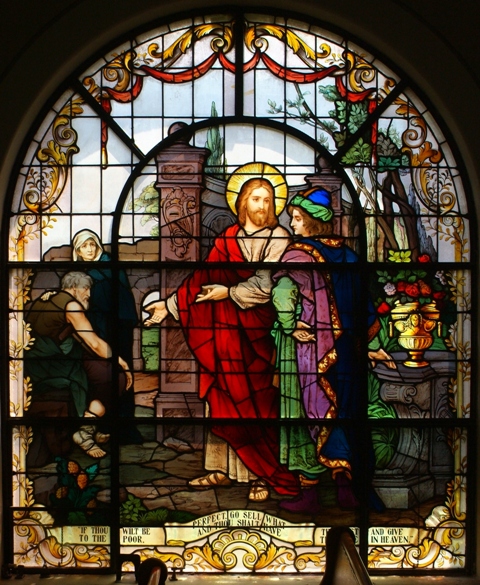
The rich young man
The Evangelists Matthew and Mark recount the story of the rich young man. Matthew tells how a young man approached Jesus at a gathering and kneeling before him, asked, “Good master, what good shall I do that I may have life everlasting?” To which Jesus replied, “Why askest thou me concerning good? One is good, God. But if thou wilt enter into life, keep the commandments.” The teacher then enumerated several commandments including “thy shall honour thy mother and father.” The young man retorted that he had kept the commandments since his youth and desired now to know “what is yet wanting to me?” Jesus answered again, “If thou wilt be perfect, go sell what, thou hast, and give to the poor, and thou shalt have treasure in heaven: and come follow me.” When the young man heard these words, he went away sad, for he had a great many possessions.
A window in the choir loft at St. John’s offers a fresh elaboration of the story, one with special meaning for the Chapel’s community. At the center of this half-sized window is Jesus, simply clad in a beige tunic and scarlet cloak, conversing with a young man who stands close to him. As he speaks, Jesus points to the right with his hands. The young man seems to listen to the master, though his downward glance and haughty posture suggests that he is indifferent to the message he hears and not ready to change his status in society and seek perfection. In the Gospel the young man kneels before Jesus in an act of humility. Here he is far from humble. In contrast to Jesus, he is richly attired in a matching tunic, cloak and hat of pale green, lavender and royal blue with gold trimming. The richness of the fabric, its ornate brocade and costly dyestuffs bespeak of his immense wealth. To the right of the men, an elderly man and woman, shabbily dressed, huddle together and witness the scene before them. The event transpires against an architectural ruin in the classical style, such as found in other windows in the Chapel. The text at the bottom reads, “If thou wilt be perfect, go sell what, thou hast, and give to the poor, and thou shalt have treasure in heaven.”(Matt. 19: 21) The writing and other details of the window are only visible in the choir loft. Nonetheless, the ostentatious dress of the young man and his conversation with Jesus makes the subject easily identifiable from the nave.
Why has the artist replaced the crowd mentioned in the Gospels with an elderly couple? One reason might be to avoid visual and thematic repetition, for several windows in the nave depict Jesus speaking to large groups. In fact, one window represents the same Gospel passage that mentions the rich young man (Jesus blessing the children). Or, perhaps the artist wanted the imagery to speak more directly to the students who attend St. John’s. The presence of the old couple and Jesus’ act of pointing to them prompt us to read them on first glance and particularly from the nave as the boy’s parents. As mentioned above, in the story Jesus specifically tells the young man to honor his mother and father as a means to eternal life. Obeying one’s elders, whether parents or teachers, is important to the spiritual life as well as to academic success. The most likely solutions is that the couple represents the poor that Jesus speaks of in his statement to the youth and which are mentioned in the quote at the bottom of the window. The couple’s tattered garments—only visible upon close inspection of the window—and the man’s crutch are clear signs of poverty and need. Thus one of the window’s messages is: giving to the poor and needy, either in the form of money or time, is an essential part of Christian life.
Jesus’ act of gesturing to the archway and countryside beyond could be an allusion to the concept of the pilgrimage of life. According to this idea, life is a pilgrimage that ultimately leads to God. Late medieval art often depicts this pilgrimage as a traveler about to set off on a journey through a rocky or hilly landscape, as the spiritual life is full of trials and tribulations. Doesn’t Jesus seem to be beckoning the rich young man to follow him through an unknown and potentially dangerous landscape? At the same time he is assuring the young man that all will be well: he will have treasure in heaven—a far better reward than luxurious clothes. By extension Jesus is asking all of us who gaze upon the window to follow him and depend more fully upon his providence to supply our needs.